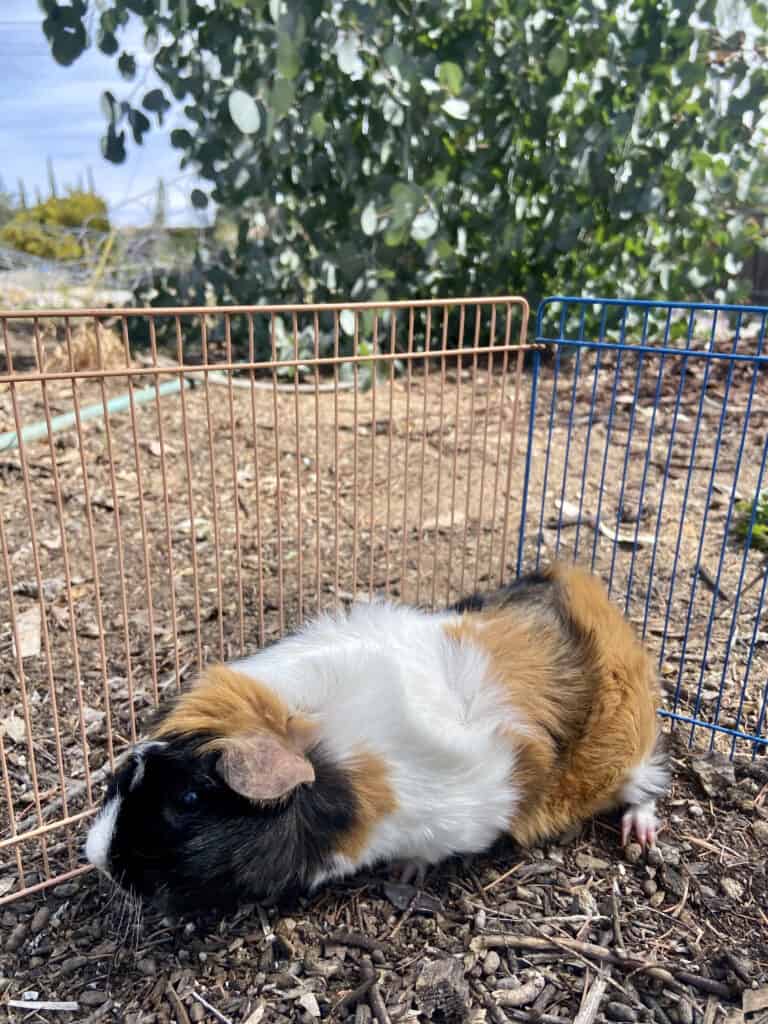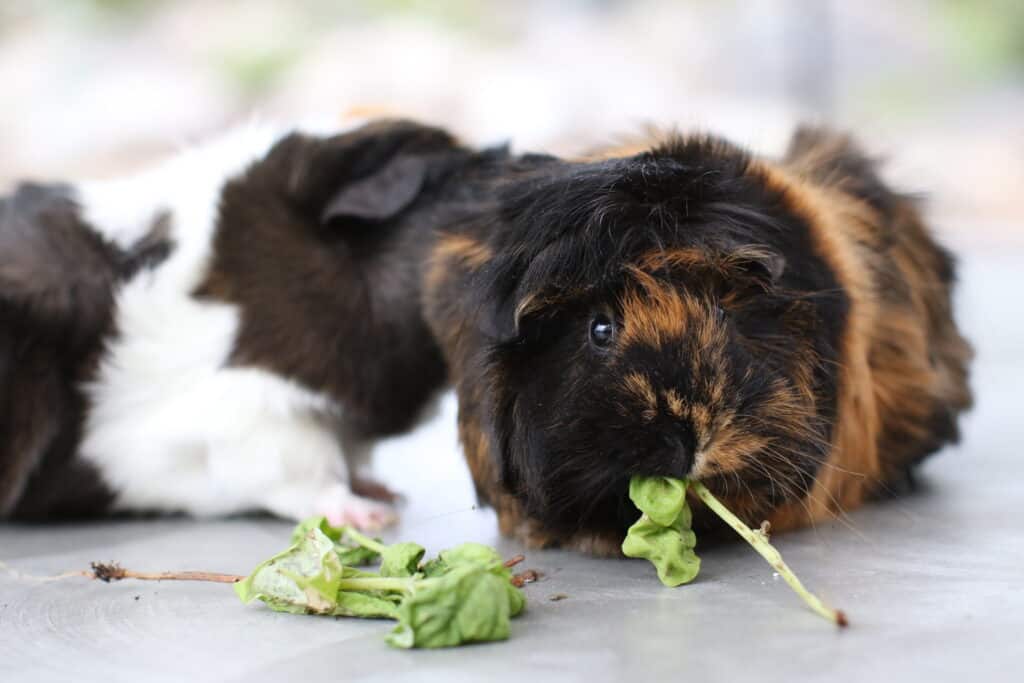As an Amazon Associate we earn from qualifying purchases.
Can guinea pigs eat bell peppers?
Bell peppers are rich in vitamins A and C and possess many health benefits for guinea pigs. They also contain some fiber and water. When feeding bell peppers to guinea pigs, it is best to give them only a small amount at a time.
Bell Peppers
The bell pepper is the fleshy fruit of Capsicum annuum plants, which belong to the Grossum cultivar group. The plant produces a variety of colored fruits, including red, yellow, orange, green, white, and purple.
The most common type of bell pepper in the United States is the green bell pepper.

They get their name from their bell-like shape and can be found in various colors, including green, red, yellow, orange, and purple.
These vegetables are a good source of vitamins A and C and potassium, folic acid, and fiber. They’re very rich in minerals and have high water content.
Nutritional Content Of Bell Peppers
Bell Peppers are a rich source of Vitamin C, a water-soluble vitamin and powerful antioxidant. One cup of green bell pepper (raw) provides 160% of the daily value for Vitamin C. Red and yellow bell peppers are even higher in Vitamin C, providing 340% and 530% of the daily value.
Vitamin C is essential for several reasons. It helps boost the immune system, aids in absorbing iron, and helps maintain healthy skin and connective tissue.
Bell peppers contain Vitamin-A, providing 20% of the daily value in one cup (raw). Vitamin-A is essential for vision, skin health, and immune function.
In addition to vitamins A and C, bell peppers also contain potassium, folic acid, and fiber. Potassium is an electrolyte that helps maintain fluid balance in the body and is vital for muscle function. Folic acid is essential for pregnant women as it helps prevent specific congenital disabilities. Fiber helps to keep the digestive system healthy and promotes regularity.
Can Guinea Pigs Eat Bell Peppers?
Guinea pigs can eat bell peppers, including green, red, yellow, orange, and purple.
They’re a good source of vitamins A and C and potassium, folic acid, and fiber.
They’re one of the most delicate vegetables you could give to the guinea pig. Vitamin C is one of the reasons for this, as it is high in content – something that a guinea pig requires a lot of since they cannot produce it themselves.
Health Benefits For Guinea Pigs
Health benefits include:
Good Digestion
They are high in water and fiber content, vital for a healthy digestive system. The fiber in bell peppers helps to keep the digestive system healthy and promotes regularity.
The high water content of bell peppers also helps to keep the digestive system hydrated and functioning properly.
Boosts Immunity
They are a good source of vitamin C, essential for a robust immune system. Vitamin C helps to boost the immune system and protect against infection.

Aids in healing
The high vitamin C content of bell peppers also helps to promote healing. Vitamin C is required to synthesize collagen, an essential protein for repairing tissues and maintaining healthy skin and connective tissue.
Reduces Inflammation
Rich source of antioxidants, which help to reduce inflammation. The vitamins A and C in bell peppers are both powerful antioxidants that help to protect against cell damage and reduce inflammation.
Helps With Poor Vision
Vitamin A is essential for vision, and bell peppers are a good source of this nutrient. Vitamin A helps to maintain healthy eyesight and prevent vision problems.
Keeps Track Of Healthy Blood Vessels
Bell peppers have folic acid, which is vital for maintaining healthy blood vessels. Folic acid helps to prevent congenital disabilities and keeps the blood vessels healthy.
Vitamin C and Scurvy Prevention
Vitamin C is necessary for the prevention of scurvy. Scurvy is a disease caused by a deficiency of vitamin C. Symptoms include fatigue, muscle weakness, joint pain, and bleeding gums.
Vitamin C helps to prevent scurvy by assisting the body in absorbing iron. Iron is essential for producing red blood cells, which carry oxygen to the tissues. Without enough iron, the body cannot produce enough red blood cells, and scurvy can develop.
Vitamin C is also essential for the healing of wounds. Vitamin C helps the body to produce collagen, a protein that is important for the repair of tissues.
Side Effects Of Bell Peppers For Guinea Pigs
There are no known side effects of bell peppers for guinea pigs. However, as with any new food, it’s important to introduce it slowly. Start with a small piece of bell pepper and see how the guinea pig reacts. If there are no adverse reactions, you can offer more the next time.
Too much vitamin C can cause diarrhea in guinea pigs. If a guinea pig eats too many bell peppers and develops diarrhea, cut back on the amount, you’re feeding and offer more water.
As with any new food, it’s essential to watch for signs of allergies. Allergies can cause diarrhea, vomiting, and difficulty breathing. Stop feeding bell peppers to a guinea pig and contact your veterinarian if you notice these symptoms.
Other Healthy Vegetables For Guinea Pigs
Other vegetables that are safe for guinea pigs and offer health benefits include:
Carrots
Carrots are a good source of fiber, beta-carotene, and vitamins A, B6, and C. Beta-carotene is converted to vitamin A in the body and is essential for vision, bone growth, and cell division.
Vitamin A is also important for the health of the skin and mucous membranes. Vitamin B6 is necessary for the metabolism of proteins and carbohydrates. Vitamin C helps boost the immune system and aids in iron absorption.
Green beans
Green beans are a good source of fiber, vitamins A, C, and K. Vitamin A is essential for vision, bone growth, and cell division. Vitamin C helps boost the immune system and aids in iron absorption. Vitamin K is necessary for blood clotting.
Cucumbers
Cucumbers are a good source of fiber, vitamins B and C, and potassium. Vitamin B is necessary for metabolism. Vitamin C helps boost the immune system and aids in iron absorption. Potassium is an electrolyte that is important for heart function and muscle contraction.
Zucchini
Zucchini is a good source of fiber, vitamins A and C, and potassium. Vitamin A is essential for vision, bone growth, and cell division. Vitamin C helps boost the immune system and aids in iron absorption. Potassium is an electrolyte that is important for heart function and muscle contraction.
Pumpkin
Pumpkin is a good source of fiber, beta-carotene, and vitamins A, C, and E. Beta-carotene is converted to vitamin A in the body and is essential for vision, bone growth, and cell division. Vitamin A is also important for the health of the skin and mucous membranes.
Final Thoughts
Bell peppers are a healthy and nutritious treat for guinea pigs. They’re an excellent source of vitamin C, fiber, and water. Bell peppers can help to boost the immune system, aid in healing, and reduce inflammation.
When introducing bell peppers to a guinea pig’s diet, start with a small piece and watch for any adverse reactions. If your guinea pig tolerates bell peppers well, you can offer them more the next time.